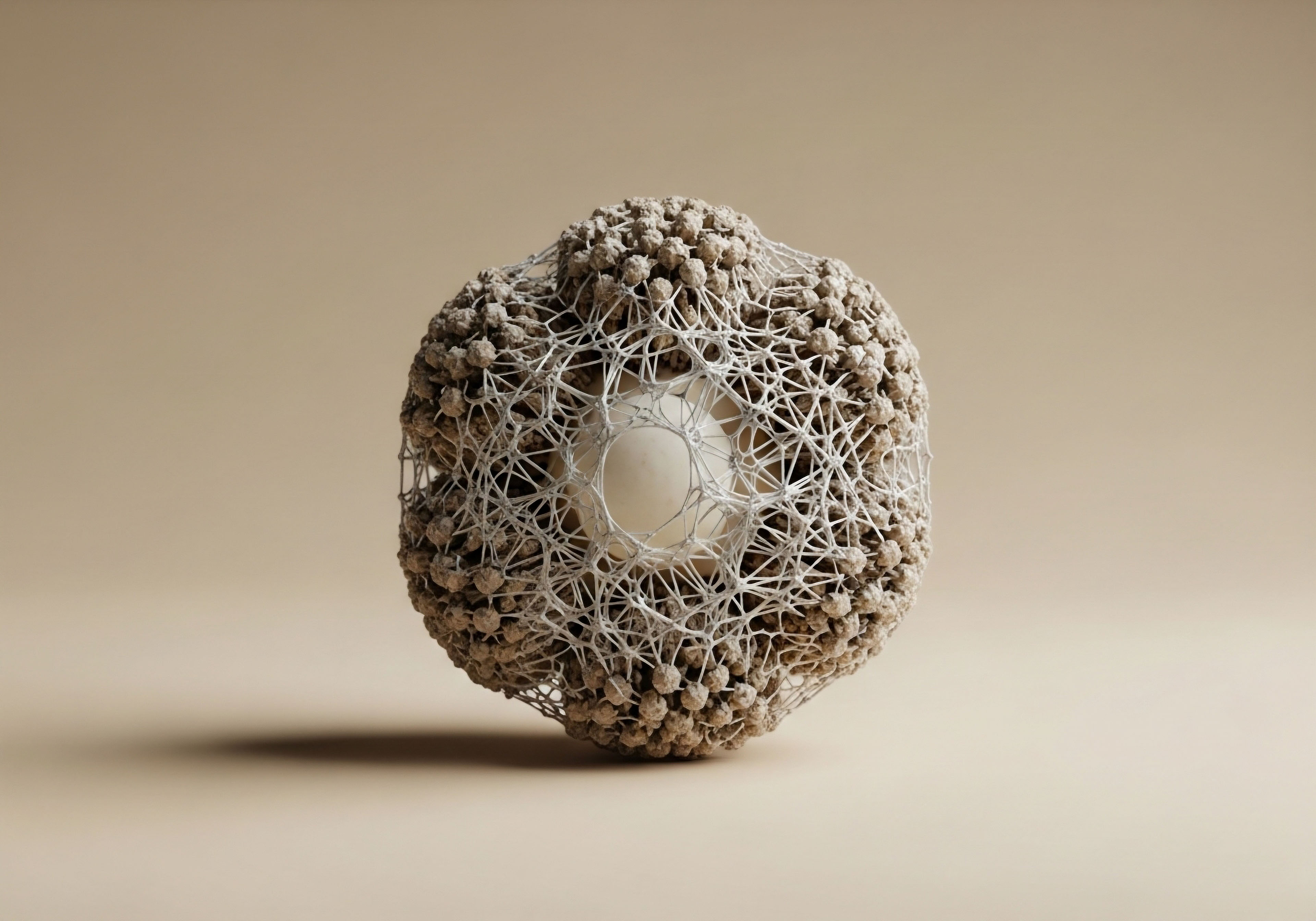

Fundamentals
Experiencing fluid retention while using peptide therapies can be a disconcerting feeling. You begin a protocol intended to enhance your body’s function and vitality, only to find yourself dealing with bloating, swelling, or a general sense of puffiness. This physical manifestation is your body communicating a complex internal adjustment process.
The sensation of holding excess water is a direct signal that powerful hormonal and renal mechanisms have been engaged. Understanding this biological conversation is the first step toward managing it effectively.
Peptide therapies, particularly those designed to stimulate growth hormone (GH) secretion, initiate a cascade of physiological events. These peptides, such as Sermorelin or Ipamorelin, work by signaling the pituitary gland to produce and release more HGH. This increase in circulating growth hormone has profound effects throughout the body, including on the systems that regulate fluid and electrolyte balance.
The body, in its intricate wisdom, is responding to a new set of instructions, and fluid retention is a common, often temporary, consequence of this recalibration.

The Hormonal Axis and Fluid Balance
At the heart of this fluid retention are two key hormones ∞ vasopressin (also known as antidiuretic hormone, or ADH) and aldosterone. When you begin a growth hormone-stimulating peptide protocol, your body may initially interpret the resulting physiological shifts as a state of dehydration, even if you are drinking enough water.
This perception triggers an increased release of vasopressin and aldosterone. Vasopressin acts on the kidneys, instructing them to reabsorb more water, leading to less urination. Simultaneously, aldosterone signals the kidneys to hold onto sodium. Because water follows sodium via osmosis, this dual action significantly increases the amount of fluid retained in your tissues.
The body’s initial response to certain peptide therapies can mimic a state of dehydration, triggering hormones that cause the kidneys to retain both salt and water.
This response is a normal adaptive mechanism. Your body is attempting to find a new state of equilibrium, or homeostasis, in response to the potent signals from the peptide therapy. The communication between growth hormone, the kidneys, and these fluid-regulating hormones is a delicate dance.
The initial period of fluid retention is often a sign that the therapy is working, setting in motion the very changes you are seeking, such as cellular repair and metabolic optimization. The key is to support your body through this adjustment phase with targeted strategies that address the root causes of the fluid imbalance.

Why Dehydration Can Paradoxically Worsen Retention
It may seem counterintuitive, but insufficient water intake can exacerbate the fluid retention caused by peptide use. Many individuals beginning these protocols are in a state of sub-optimal hydration without realizing it. When the body is even slightly dehydrated, blood becomes more concentrated, which is a powerful stimulus for the release of vasopressin and aldosterone.
Adding growth hormone-stimulating peptides on top of this pre-existing state amplifies the water-retaining effects. Your body, already primed to conserve water due to dehydration, receives a second, potent signal from the therapy to hold onto even more fluid and sodium.
Therefore, one of the most foundational steps in mitigating this side effect is ensuring you are consistently and adequately hydrated. This helps to dilute the blood, signaling to the body that it can release its tight grip on water and sodium, allowing homeostasis to be restored more quickly.


Intermediate
For individuals familiar with the basic hormonal mechanisms driving peptide-related fluid retention, the next step involves implementing specific, targeted dietary and lifestyle modifications. These strategies move beyond simple hydration and address the nuanced interplay between nutrients, electrolytes, and the renal system. By proactively managing these factors, you can significantly mitigate the discomfort of edema and support your body’s adaptation to growth hormone-releasing peptide (GHRP) therapy.
The core principle is to counteract the effects of aldosterone and vasopressin. While the peptides are stimulating the pituitary, your lifestyle choices can send opposing signals to your kidneys. This involves not just what you consume, but also how you move and manage daily stressors. It’s a systematic approach to re-establishing fluid equilibrium, turning a potentially disruptive side effect into a manageable part of the optimization process.

Strategic Dietary Interventions to Manage Fluid
A well-formulated diet is your primary tool for controlling peptide-induced water retention. The focus should be on reducing sodium intake while increasing the consumption of key minerals that promote fluid balance. This requires a conscious shift away from processed foods, which are typically high in sodium, and toward whole, nutrient-dense options.

The Sodium-Potassium Balance
Potassium is the physiological antagonist to sodium. It works to counteract sodium’s effects, encouraging the kidneys to excrete excess sodium and water, thereby reducing fluid buildup and supporting healthy blood pressure. Many modern diets are disproportionately high in sodium and low in potassium, a combination that primes the body for fluid retention. When using peptides that stimulate aldosterone, this imbalance becomes even more pronounced.
- Increasing Potassium ∞ Prioritize foods like avocados, spinach, sweet potatoes, bananas, and coconut water. These are rich in potassium and can help restore the necessary electrolyte gradient that signals the body to release excess fluid.
- Reducing Sodium ∞ The most effective way to lower sodium intake is to minimize or eliminate packaged and processed foods. Restaurant meals and fast food are also significant sources of hidden sodium. Cooking at home allows for complete control over the amount of salt in your food.

The Role of Magnesium and B-Vitamins
Magnesium is another crucial mineral involved in hundreds of enzymatic reactions, including those that regulate fluid balance and nerve function. A deficiency in magnesium can contribute to water retention. Similarly, Vitamin B6 has been shown to be effective in reducing fluid retention, particularly in cases related to hormonal fluctuations. Supplementing with these nutrients or increasing their dietary intake can provide additional support.
A diet rich in potassium and magnesium, coupled with a reduction in processed sodium, directly counteracts the primary hormonal drivers of fluid retention.

Lifestyle Adjustments for Optimal Fluid Dynamics
Beyond diet, certain lifestyle habits can have a significant impact on how your body manages fluid. Regular physical activity and stress management are two powerful levers you can pull to support your system’s adaptation to peptide therapy.
Regular exercise, particularly activities that involve muscular contraction in the lower limbs like walking or cycling, helps to stimulate the lymphatic system and improve circulation. This mechanical action assists in moving excess fluid out of the extremities and back into central circulation, where it can be processed by the kidneys. Furthermore, sweating during exercise helps to excrete both water and sodium, providing a direct route for fluid release.
| Strategy | Mechanism of Action | Practical Application |
|---|---|---|
| Sodium Reduction | Decreases the primary electrolyte that causes water retention via osmosis. | Avoid processed/packaged foods; cook meals at home using minimal salt. |
| Potassium Increase | Counteracts sodium’s effects and promotes urinary excretion of water. | Consume avocados, leafy greens, bananas, and other potassium-rich foods. |
| Adequate Hydration | Suppresses the release of vasopressin (ADH) and aldosterone. | Drink water consistently throughout the day, even before feeling thirsty. |
| Regular Exercise | Improves circulation, stimulates lymphatic drainage, and releases fluid through sweat. | Engage in daily physical activity, including cardiovascular and resistance training. |


Academic
A sophisticated understanding of peptide-induced fluid retention requires an examination of the specific renal and endocrine pathways affected by growth hormone (GH) and its secretagogues. The phenomenon is primarily a consequence of GH’s direct and indirect actions on the kidney’s handling of sodium and water, mediated through a complex interplay of the renin-angiotensin-aldosterone system (RAAS), vasopressin (ADH), and atrial natriuretic peptide (ANP).
Certain peptides, especially those in the growth hormone-releasing peptide (GHRP) class like GHRP-2 and GHRP-6, can also have actions independent of GH secretion that contribute to this effect, such as stimulating cortisol and aldosterone directly.
The clinical manifestation of edema is therefore a predictable outcome based on the pharmacodynamics of these therapeutic agents. Mitigating this effect effectively relies on interventions that specifically target these underlying physiological mechanisms. While dietary sodium restriction is a foundational concept, a more advanced approach involves modulating the entire system through precise nutritional and lifestyle inputs that influence renal tubular function and hormonal signaling.

Renal Physiology and Peptide Influence
Growth hormone exerts its primary fluid-retaining effect at the level of the renal tubules, specifically the distal tubules and collecting ducts. Research suggests that GH, likely mediated by Insulin-like Growth Factor 1 (IGF-1), enhances the activity of the epithelial sodium channel (ENaC) and the Na+/K+-ATPase pump.
This leads to increased reabsorption of sodium from the filtrate back into the bloodstream. As water passively follows sodium, total body water increases. This is a direct antinatriuretic effect. Concurrently, GH can stimulate the release of ADH from the posterior pituitary and potentiate its action on the collecting ducts, increasing the expression of aquaporin-2 channels and leading to greater water reabsorption.

How Do Peptides Influence the RAAS System?
The renin-angiotensin-aldosterone system is a critical regulator of blood pressure and fluid balance. GH appears to stimulate this system, leading to increased production of angiotensin II and, subsequently, aldosterone from the adrenal cortex. Aldosterone further promotes sodium reabsorption and potassium excretion in the distal nephron.
Some peptides may have a more direct effect. For example, while Ipamorelin is noted for its high specificity and minimal impact on aldosterone, other peptides like GHRP-2 or Hexarelin can cause transient increases in both cortisol and aldosterone, compounding the fluid retention effect. This makes peptide selection a key variable in managing potential side effects.
| Peptide | GH Release | Impact on Aldosterone/Cortisol | Potential for Fluid Retention |
|---|---|---|---|
| Sermorelin/CJC-1295 | Strong | Minimal/None | Moderate (via GH/IGF-1 pathway) |
| Ipamorelin | Strong | Minimal/None | Moderate (via GH/IGF-1 pathway) |
| GHRP-6 / GHRP-2 | Very Strong | Can cause transient increases | High (dual mechanism ∞ GH and direct stimulation) |
| Tesamorelin | Strong | Minimal/None | Moderate (via GH/IGF-1 pathway) |

Advanced Mitigation Strategies Based on Physiology
Understanding these mechanisms allows for the development of highly specific countermeasures. The goal is to create a physiological environment that opposes the sodium- and water-retaining signals generated by the peptide therapy.
- Targeted Mineral Loading ∞ Beyond simply increasing potassium, a strategic approach involves ensuring an optimal ratio of potassium to sodium. This can be calculated and tailored to an individual’s diet. Additionally, ensuring adequate magnesium intake is vital, as magnesium is a natural calcium channel blocker, which can have a mild diuretic effect and also helps regulate the Na+/K+-ATPase pump.
- Herbal Diuretics and ANP Support ∞ Certain herbal compounds, such as dandelion root and parsley, have natural diuretic properties that can help increase urine output. More targeted interventions could focus on supporting the body’s own system for combating fluid retention ∞ the atrial natriuretic peptide (ANP) system. GH has been shown to suppress ANP, a hormone that promotes sodium and water excretion. Regular cardiovascular exercise is a potent stimulator of ANP release, providing a direct physiological counter-signal to the effects of GH.
- Managing Glycemic Load ∞ High insulin levels can also promote sodium retention by the kidneys. Many individuals using peptides for anabolic or body composition purposes may also be consuming higher carbohydrate diets. Carefully managing the glycemic index and load of carbohydrate intake can prevent insulin-driven fluid retention from compounding the effects of the peptide therapy. A diet with a lower glycemic index may be beneficial.
The most effective mitigation protocols are those that create a multi-pronged physiological counter-pressure against the specific renal and endocrine actions of the chosen peptide.
Ultimately, effectively managing peptide-induced fluid retention is a process of applied physiology. It requires a detailed understanding of the therapy’s mechanism of action and the implementation of precise, evidence-based dietary and lifestyle strategies that directly counteract it. By moving beyond generic advice and targeting the specific pathways involved, individuals can continue to reap the benefits of peptide therapies while maintaining optimal fluid balance and well-being.

References
- Møller, J. et al. “Growth hormone administration and dehydration.” Journal of Clinical Endocrinology & Metabolism, vol. 82, no. 12, 1997, pp. 3980-3985.
- Verbalis, J. G. “Disorders of body water homeostasis.” Best Practice & Research Clinical Endocrinology & Metabolism, vol. 17, no. 4, 2003, pp. 471-503.
- Sigalos, J. T. and A. W. Pastuszak. “The Safety and Efficacy of Growth Hormone Secretagogues.” Sexual Medicine Reviews, vol. 6, no. 1, 2018, pp. 45-53.
- Laferrère, B. et al. “Ghrelin and growth hormone-releasing peptide-2 stimulate energy expenditure and fuel oxidation in obese humans.” The Journal of Clinical Endocrinology & Metabolism, vol. 90, no. 2, 2005, pp. 933-939.
- “Peptides for Bodybuilding ∞ Do They Work, and Are They Safe?.” Healthline, 3 Dec. 2020.
- “6 Ways to Reduce Water Retention (Edema).” Healthline, 11 Jul. 2023.
- “Growth Hormone Stimulating Peptide Therapy – Fort Myers & Naples – Contemporary Health Center.” Contemporary Health Center, 10 Jul. 2025.
- “IV Nutrient Therapy for Wellness.” NuVO Medical Associates.
- “Anti-Aging Peptide Therapy ∞ The Top 12 Questions Answered.” Rejuvenated Medical Spa, 26 Oct. 2022.
- “Research and prospect of peptides for use in obesity treatment (Review).” Spandidos Publications, 2019.

Reflection
You have now seen the intricate biological systems that govern fluid balance and how peptide therapies can influence them. This knowledge transforms the conversation from one of simply dealing with a side effect to one of actively managing your body’s internal environment. The swelling in your hands or the puffiness in your face is a data point, a signal from a complex system undergoing a significant, positive change. It is an invitation to engage more deeply with your own physiology.

What Is Your Body’s Unique Language?
Consider how your body has communicated with you in the past. Every symptom, every sensation, is a piece of information. The knowledge gained here is a tool for interpretation, allowing you to translate these signals into actionable insights. As you apply these dietary and lifestyle strategies, observe the response.
Does your body respond more to changes in potassium, or does consistent exercise make the most significant difference? This process of observation and adjustment is the foundation of a truly personalized wellness protocol, moving you from a passive recipient of a therapy to an active participant in your health journey. The path forward is one of continual learning and refinement, a partnership with your own biology aimed at achieving your highest potential for vitality.



